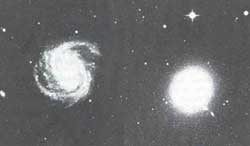Heavenly computers
 ONE of the most specialised and tedious jobs of an astronomer is classifying galaxies after examining them through a telescope. Now, computers are going to help the scientists in this task, which is important because specifying the type of galaxy gives vital clues about its origin and evolution (Science, Vol 267, No 5199).
ONE of the most specialised and tedious jobs of an astronomer is classifying galaxies after examining them through a telescope. Now, computers are going to help the scientists in this task, which is important because specifying the type of galaxy gives vital clues about its origin and evolution (Science, Vol 267, No 5199).
This is a new field for computer usage because it means employing them in what is a highly skilled job. This is because galaxy classification is to a large extent a subjective matter. What the classification scheme gives you is the correlation between certain morphological features (like the size of the central bulge, or how tightly the spiral arms wound around the core) and the type of galaxy. But to place any given image with certain characteristics into one or another type is still a matter of judgment. Fortunately though, unlike insects or plants, most of the galaxies are classified either as spiral, like our own Milky Way, or elliptical. However, within each classification, there are a few subclassifications.
Now, computer programmes called neural networks, which come closest to the human brain, are being employed in the time consuming and highly technical job of galaxy classification. Neural networks consist of interconnected processors where the processors and the connections roughly mimic the neurons and the synapses of human brain. The property that makes these models useful is that they can be made to learn from experience.
Before using the neural networks to classify galaxies, astronomers first train the networks with some 500 images of galaxies. The network classifies the image according to some features of the image and assigns different weights to these features. The network is then given the correct answer for each image and it changes the Assignment of weights so as to produce the answer closest to that given it by the trainer. The more positive reinforcement that a network gets, the better it is equipped to handle the next image.
A competition between the trained electronic apprentices and their astronomer trainers in classifying galaxies showed encouraging results, suggesting that the neural networks could soon become an indispensable tool in astronomy.
